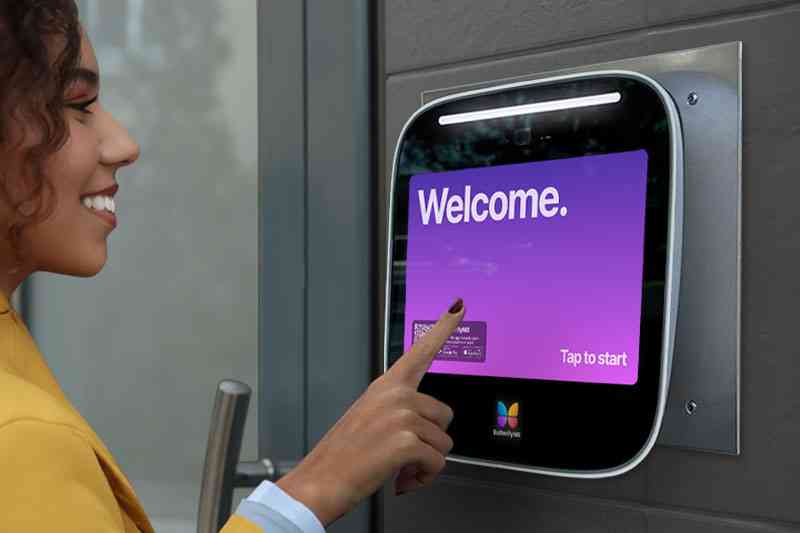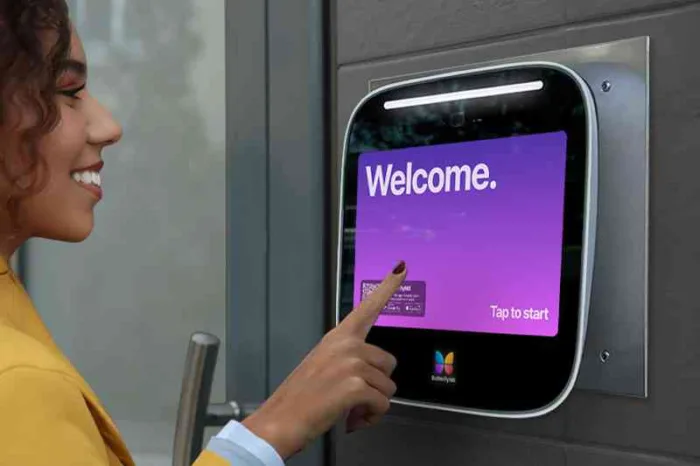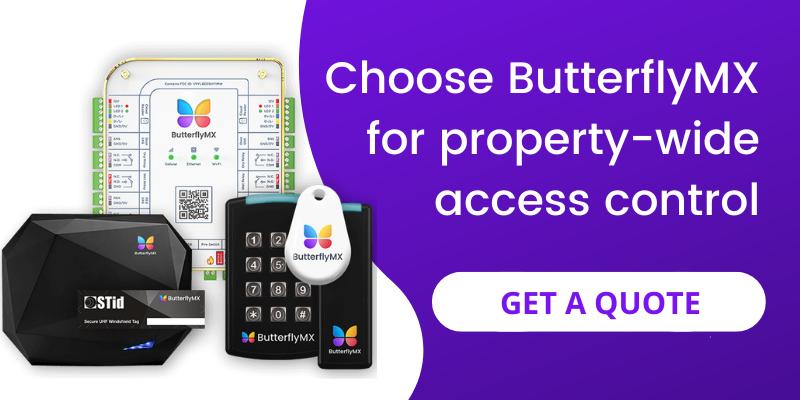Key takeaways
- The key components of an access control solution include a control panel, credentials, readers, and a release mechanism.
- When you look for an access control solution, it should be cloud-based, have a mobile app, and integrate with other systems.

ButterflyMX offers robust access control for multifamily, commercial, senior housing, and student housing properties.
Residential access control systems are designed to protect multifamily properties, such as apartments, condos, student housing, and more. With the right access control system, you can simplify access at your property for staff, residents, visitors, and service workers.
For that reason, we’ll tell you the best access control system below. You’ll also learn how to choose a system that best fits your needs, how these systems work, and the most common types available.
This post covers:
- Most robust residential access control system
- What is a residential access control system?
- How does residential access control work
- What are the most common types of residential access control?
- How to choose a residential access control system
Most robust residential access control system
ButterflyMX is a cloud-based access control company designed to simplify access and management for property owners, operators, staff, residents, and others. As a leading access control company, we’ve been installed in more than 10,000 buildings and garnered over 20,000 five-star reviews.
Our mobile-based Access Control enables property operators and owners to manage their buildings through a web-based dashboard or mobile app. That way, you can manage permissions, review entry logs, and integrate with other systems from anywhere.
Meanwhile, tenants and staff can grant themselves or their guests access via the ButterflyMX mobile app. ButterflyMX also supports other credentials, such as key cards, fobs, and PIN codes, to meet your residents’ security and convenience needs.
Above all, ButterflyMX offers a property-wide access control solution, meaning you can manage access throughout your entire property from a single dashboard, such as the front door or gate, garage, amenity spaces, individual apartments, elevators, and beyond. This type of system reduces your workload and is easier to maintain by centralizing access management in one place.
Here are some of ButterflyMX’s product offerings:
- Video Intercom
- Access Control System
- Package Room
- Vehicle Access Control
- Elevator Controls
- Front Desk Station
- Smart Locks
- Self-Guided Tours
What is a residential access control system?
A residential access control system is a solution for automating access to a multi-unit residential property — apartments, condos, student housing — to make sure only authorized people can enter.
Access control systems are installed at entrances, gates, interior doors, and elevators throughout the building. There are many different types of residential access control systems, but all share the common goal of making buildings more secure and making access more convenient.
Building access control systems can be as simple as traditional metal keys and locks. However, investing in the right solution is a simple, affordable, and efficient way to improve your property, so it’s worth considering the options available to you. While an old-fashioned lock-and-key system keeps out unauthorized visitors, it’s not convenient for your current residents and staff to manage.
How does residential access control work?
Access control can benefit all types of entryways by ensuring that only authorized people pass through. Gate and door access control systems allow you to keep entrances locked and secure 24/7 so that only approved residents, staff, and guests can access the space.
Most access control systems include these components to work:
- Control panel. The control panel stores data on tenants and their access permissions. Older access controllers often use a physical device on-site, but many newer systems store this data in the cloud, so it’s accessible remotely.
- Credentials. There are many different types of credentials. Your building may still use metal keys, or perhaps you’ve upgraded to key fobs or cards. Smart access control systems can even use mobile devices or fingerprints as credentials. In the end, all credentials serve the same purpose of storing data on who the user is and what they can access.
- Reader. Every entryway needs a reader to manage access and scan credentials. With a traditional metal lock and key, the door opens as long as the key fits. However, with more high-tech solutions, readers scan credentials and then send encrypted data to the control panel. The control panel opens the door if the user is authorized to enter.
- Door release mechanism. The door release mechanism is a device that unlocks the door so tenants, visitors, and staff can enter after scanning their credentials. It receives messages from the control panel when an authorized user is at the door and unlocks it so they can enter.
Watch how ButterflyMX works:
What are the most common types of residential access control?
There are many ways to manage access at your residential building, from old-fashioned metal keys to cloud-based contactless systems. Which apartment access control system is best for you will depend on the unique needs of your property. However, most multifamily buildings benefit from a combination of access strategies.
The top four types of residential access control systems used today are:
1. RFID systems
The technology for RFID keys has been around for a long time and is still the most popular solution for hotels today. Every resident and staff member is assigned a key card or fob to scan at the entrance to gain access. You can use these systems beyond just the front door to manage access to gyms, laundry facilities, parking garages, package rooms, and more.
RFID access control systems are often cheap to install, but the cost adds up quickly as you replace lost keys and make new ones for residents moving in. These systems also don’t allow visitors to request access, resulting in packages getting left outside or prospective residents not being able to come in for tours.
2. Cloud-based access control systems
A cloud-based access control system operates and stores data in the cloud. With a cloud-based access control system, authorized users can open doors for themselves or guests with any device that’s connected to the internet. Essentially, your residents and staff will be able to manage access from anywhere. Not only can they open the door from anywhere, but you can also update the resident directory, manage access permissions, and review entry logs remotely without having to be on-site.
Unlike RFID systems, a cloud-based access control system often also has features for visitor management. For example, the best system for residential buildings is a cloud-based video intercom. When installed at the building’s front entrance, intercoms allow visitors to contact any resident or staff member. Many cloud-based access control systems are also smartphone-based.
Furthermore, cloud-based access control is a viable option for nontraditional residential properties, such as mobile home communities, tiny home parks, or RV parks.
What is smartphone-based access control?
With mobile cloud-based access control, your staff and residents use their mobile devices – such as smartphones, tablets, and smart devices – as their access credentials. This can work in a couple of different ways. To verify access, some access readers communicate with residents’ mobile devices over Bluetooth or WiFi. Other systems operate using mobile apps so residents can receive calls from guests, accept deliveries, and open the door all from their smartphones.
3. Smart locks
Physical keys will soon be a thing of the past. Smart locks replace metal keys and enable residents to unlock their doors using a PIN code or smartphone.
Smart locks are convenient because residents no longer have to carry around keys, and your staff won’t need to worry about the hassle of making them. However, smart locks aren’t the best way to manage front door access because once residents give out the PIN code to a guest, that person can reenter the door anytime they want. Your best solution is to use smart locks for door access at the individual unit level.
4. Keypads
Like smart locks, keypads replace metal keys and locks with a more convenient solution. Keypads let users enter a PIN code to access a building or room and are a great way to manage access around your property. Some keypad access systems even allow tenants to open the door from a mobile app.
Keypads offer a convenient experience to residents and staff but don’t have an option for visitors to request access. Therefore, they’re best suited for use within the building rather than at the main entrance, where delivery couriers and guests also enter.
How to choose a residential access control system
Now that you know the different types of access control, how do you choose a system? You want to invest in a modern system that is scalable, reliable, and easy to manage. The best way to do that is with a unified, cloud-based access control system. Choose a cloud-based system with convenient hardware, like smart locks and keypads, to offer a hands-free, smartphone-based experience throughout the entire building.
Key features to look for in a cloud-based access control system:
- Property-wide solution. Your access control solution should be capable of managing access throughout your entire property, from the front door and gate to elevators and amenity spaces. That way, you don’t have to manage multiple different systems for various areas, which saves you time and money. Not to mention, you’ll have greater insight into how your system is used across all access points.
- Mobile app: The last thing you want is to spend money on technology that your residents and staff won’t use. So it’s essential to invest in a system with a great mobile app if you want to offer smartphone-based access. Check reviews on Google and the Apple Store to ensure the app is well received by people who use it.
- Integrations: Thanks to the cloud, your access control system can easily communicate with other devices and software. Choose an access control system that can integrate with your other smart devices, like locks and keypads, to offer the most seamless experience throughout the building. You can also save your staff time by choosing a system that integrates with your property management software so the resident directory automatically updates.







